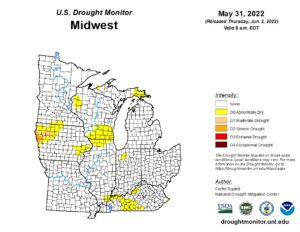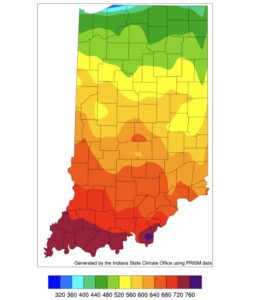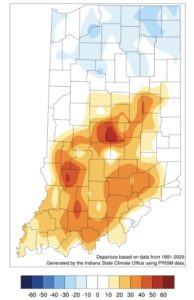June 1st marked the beginning of meteorological summer (i.e., June, July, and August). Time between sunrise and sunset is still increasing, temperatures are increasing, and vegetation is growing. How did this past spring compare to climatology and what is expected over the next several months?
Let us start with May’s climatology. May’s average temperature across Indiana was 2-4 degrees warmer than normal. These warmer temperatures were reflected in both the average maximum and minimum temperature, as well. Last month’s precipitation total was above normal throughout most of Indiana except for the counties along the Ohio River and the northwestern part of the state. This has led to the US Drought Monitor designating the first introduction of “Abnormally Dry” conditions in Indiana since last October (Figure 1)!

Figure 1. US Drought Monitor showing the introduction of Abnormally Dry (D0) conditions for a few counties in northwestern Indiana and a slight spillover of Abnormally Dry conditions in far southwestern Indiana as of May 31, 2022.
For this past spring (March-April-May), the similar pattern for precipitation occurred as for May where central and northeastern Indiana were near normal to slightly above normal, yet the southern and northwestern counties were drier than normal. What is interesting, however, is while total amounts were near normal, the number of wet days seemed to be greater than normal, meaning fewer field days and chances for the soils to dry up. This was a great example of how the timing and intensity of precipitation may be more important than total amounts, depending upon the application of interest. The average spring temperature was slightly below normal for northwestern Indiana and within 2 degrees above normal across the rest of the state.
Climate outlooks for June are indicating too much uncertainty regarding temperature and precipitation. However, above-normal temperatures are favored for the June-July-August period with equal chances of having above-, below-, or near-normal precipitation amounts. This propensity of uncertainty is likely due to the current La Niña event weakening without fully transitioning to another phase (i.e., Neutral or El Niño). These phases already have weak correlation to weather in the Midwest region, but with the current phase already weak, there are challenges to predicting with high confidence how the climate is likely to be over the next several months.
Modified growing degree-day accumulations are progressing faster in southern Indiana than in northern Indiana when considering a start date of April 15th. Central and southern Indiana has areas where the GDD accumulations are 40-60 units above the 1991-2020 climatological average for this time of year, whereas northern Indiana is only 10-30 units below average (Figures 2 and 3).

